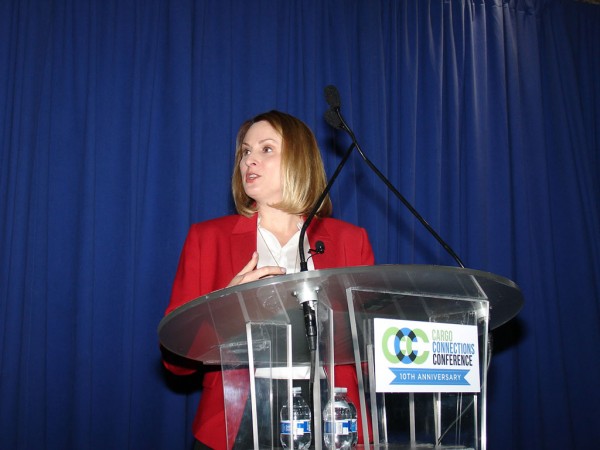CMA CGM exec calls for industry transformation in opening conference hosted by Port of New Orleans
The ocean shipping industry demands customer-focused transformation, according to a top carrier executive speaking today [Monday, April 9] at the Cargo Connections Conference in New Orleans.
“The customer journey needs a redesign,” saidNick Fafoutis, senior vice president of sales and chief commercial officer of CMA CGM (America) LLC, the Norfolk, Virginia-based arm of the France-headquartered ocean carrier. “It’s time to effect positive change for all of us.”
In the opening keynote address of the 10th anniversary Cargo Connection Conference, hosted by the Port of New Orleans at The Chicory, Fafoutis said the bankruptcies, consolidations and mergers of recent years have led to a time – with the top four carriers controlling 60 percent of total industry capacity – in which scale seems to have overtaken service.
“The shipping world is change, folks, and it’s changing fast,” Fafoutis said, noting that the emergence of burgeoning carrier alliances and larger containerships has resulted in less choice for customers. “They’ve sacrificed quality for scale.
“We need to put those days behind us,” he said. “We don’t want to be a number on a spreadsheet.”
Fafoutis said it is imperative that value be created through long-term relationships and abandonment of the traditional silo mentality, commenting, “We, as an industry, have got to start working together.”
CMA CGM’s six building blocks for transforming the customer experience, according to Fafoutis, are:
- Service level differentiation
- Sales effectiveness
- Digital agency operations
- New products and services, including through the company’s rollout of a leading-edge insurance program
- Customer understanding, including through a series of customer workshops
- Marketing proficiency
Fafoutis said a collaborative approach is particularly important as the industry grapples with numerous challenges, including:
- Trucking capacity
- Equipment imbalance
- Chassis availability
- Container weight regulations
- Volume forecasting
- Booking shortfalls
“Trucking remains a major issue here in the U.S.,” he said, expounding upon the first point. “In some markets, it’s almost impossible to find trucks.”
In the current industry environment, CMA CGM has fared better than most. Following its acquisition of APL, CMA CGM achieved more than $21 billion in revenue last year, while it 7.4 percent operating margin was the best among ocean carriers.
CMA CGM, which has called the Port of New Orleans since 2009, augmented its weekly Caribbean/Latin America and Northern Europe service calls in late 2016 and early 2017 with a pair of additional direct weekly container services – one going to and from Asia and the other serving ports of Brazil as well as Mexico, Jamaica, Colombia and Panama. CMA CGM, Fafoutis said, now represents 22 percent of containerized cargo volume at the Port of New Orleans.
Prior to the keynote, Brandy Christian, who became president and chief executive officer of the Port of New Orleans in January 2017, said diversity is becoming increasingly important for the port with potential impacts of newly implemented U.S. tariffs.

“Diversity and connections make the Port of New Orleans a great global gateway,” Christian said, noting that the port derives revenues from four business segments: cargo, split evenly between breakbulk and containerized shipments; cruise, having become the nation’s sixth-busiest cruise port; real estate; and rail, with the port’s recent acquisition of the New Orleans Public Belt Railroad and enhanced partnerships with the six Class I railroads serving the port.
Christian noted that the port’s new master plan includes efforts to attract more imports to balance extensive export volumes of plastic resins and other commodities.
The four pillars of the master plan, ad presented by Christian, are:
- Operate efficiently
- Capitalize upon the port’s status as a gateway
- Strengthen relationships and connect with stakeholders
- Develop in a sustainable manner
Look for further reports later this week at www.ajot.com and comprehensive coverage of the Cargo Connections Conference in the April 23 print edition.
© Copyright 1999–2024 American Journal of Transportation. All Rights Reserved

